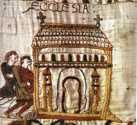 Adbolton Adbolton
All Hallows
History
Adbolton is a tiny hamlet in the administrative area of West Bridgford but in the current ecclesiastical parish of Holme Pierrepont. It is a shrunken medieval village, though the size and population of the settlement in the medieval period was evidently never great.
Domesday Book records that Godwin the priest had land in Adbolton and there was a church; this may be unusually indicative of the existence of an Anglo-Saxon church here, as Godwin the priest was a landholder before the Conquest and almost certainly had a church in Adbolton at that time. Interestingly, the taxable value of the manor had doubled since before 1066 from 10s to 20s, probably due to the influence of William Peverel, the principal landowner, who had considerable influence and vast holdings elsewhere.
In 1268 John de Rye held demesne lands in Adbolton but there are no details relating to the church documented at this time. In 1302, Robert de Strelley held lands in Adbolton and in 1303 the advowson was granted to Sampson de Strelley and Phillipa his wife, and to their heirs. The Strelley family was still in occupation of the land in 1428 (indeed, we know they had been there since at least 1212 when Walter de Strelley had interests in the parish). We have few details of the form of the building that once stood here but we know that Alderman Rose of Nottingham bequeathed 30s, to the church in 1528, though in 1559 it had been closed for two years and there had been no worship during that time. In the Valor Ecclesiasticus of 1534-5 the church was worth £2 13s 8d and William Warton was rector at that time; eight years later, in 1543, the church is mentioned in an indenture relating to the payment of benevolence or 'devotion money' imposed by Henry VIII. In 1552 there were two small bells and a handbell. There is no indication that Adbolton was ever appropriated by any monastic house.
At the Visitation of 1559, following the implementation of the Act of Uniformity, Edward Sandys and Henry Harvey, along with Edward, Earl of Derby and Thomas, Earl of Northumberland, William Lord Evers and several others, found the parish of Adbolton to be without a curate and was therefore sequestrated: William Lee and Thomas Clay, two of the parishioners were appointed administrators.
The church was ‘in decay’ in 1601 and by 1677 it had been reduced from a rectory to a vicarage; its list of clergy ends in 1691. In 1650 the Parliamentary Commissioners valued the rectory, or parsonage, at £20 per annum; at this time The Earl of Kingston was patron, and Thomas Leeke, clerk, then incumbent, had the profits of the living to his own use and ministered to the parish himself, along with an assistant.
Between 1635 and 1639 the relatively small sum of £13 7s was expended on repairs and improvements, including a new chancel rail. The population of Adbolton had never been large (in 1603 the churchwardens had returned that: 'Our people be few but willinge…’) and in 1707 the parish was annexed to nearby Holme Pierrepont by Archbishop Sharp. In 1743, Archbishop Herring reported that there was no house or parishioner belonging to the church and that, although the building was still standing, it was ruinous.
The church was demolished in 1746, the materials being sold for £12 7s 6d (bricks and tiles £3 12s; stone £1 10s; wood £1 15s; bells, £5 10s. 6d) the stone was for reuse at Holme Pierrepont and Gamston; the communion plate was moved to Holme Pierrepont, although a silver cup was apparently sold to the rector, with the consent of the parish, for 17s., and a silver spoon, of 17s. value bought in its stead. Today there are no visible remains above ground. In 1834 the site was levelled, the foundation of the tower was excavated, and various human remains were unearthed; some of the gravestones went to make a pavement for an adjoining farm. The exact location of the church is unknown. However, according to James Orange, writing in 1840, the places of the graves in the field, owned by a Mr J Spencer, clearly marked out the site of the churchyard, and the foundations of the church were plainly distinguishable. Orange states that the tower at the west end was ‘six paces square’, the length of the church, from west to east, ‘about twenty’, the breadth ‘about eight’, and there was one aisle on the south side, ‘making it in all nearly eleven paces wide’. In 1840 there was a stone where the tower once stood.
| 




